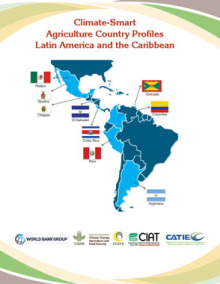
The threat of climate change is by no means uniform and, on the contrary, affects each country differently. Photo: Neil Palmer / CIAT
Farmers and agricultural experts across Latin America and the Caribbean know quite a bit about climate-smart agriculture or CSA. But only if each country really knows what it knows about this pioneering approach, can the rural sector succeed in opening pathways towards CSA.
With @WorldBank support, @CIAT_&@CATIEOficial jointly undertook a new initiative on #climatesmart #agriculture: http://t.co/nIK9EPwfT2 #CSA
— CCAFS cgiarclimate (@cgiarclimate) November 1, 2014
In a timely effort to help meet this requirement, climate experts at CIAT and the Tropical Agricultural Research and Higher Education Center (CATIE) embarked on a new initiative, with support from the World Bank, to develop a product referred to as CSA Profiles for countries and subnational areas within the LAC region.
“The idea is to help mainstream CSA by raising awareness and initiating dialogues about entry points for action by governments and financing institutions,” said Caitlin Corner-Dolloff, a climate change expert at CIAT and one of the project leaders.
The first products of this partnership consist of nine country profiles, covering seven countries (Argentina, Colombia, Costa Rica, El Salvador, Grenada, Mexico, and Peru) as well as the states of Chiapas and Sinaloa in Mexico. The profiles were prepared in consultation with government ministries and agencies as well as representatives of the private sector and civil society, thus setting the baseline to gauge progress in CSA.
“This work shows many examples of climate-smart agricultural practices and demonstrates that national organizations want to scale them out,” said Bastiaan Louman, who leads research on climate change at CATIE. “Climate change demands immediate action, and the profiles indicate what can be done now to improve the enabling conditions for CSA.”
 The complete set of profiles (available in Spanish and English) was presented last October to a standing-room-only audience at World Bank headquarters in Washington, D.C., USA. Using attractive infographics to convey key messages at a glance, each profile describes the overall context of agriculture and climate change, surveys climate-smart technologies and practices that have already been adopted, explains the institutions and policies in place to advance these options, assesses opportunities for financing them, and presents case studies on especially promising initiatives. After the presentation, Juergen Voegele, the World Bank’s senior director for agriculture global practice, stressed the Bank’s commitment to climate-smart programs: “You cannot have an agricultural development strategy that ignores climate change.”
The complete set of profiles (available in Spanish and English) was presented last October to a standing-room-only audience at World Bank headquarters in Washington, D.C., USA. Using attractive infographics to convey key messages at a glance, each profile describes the overall context of agriculture and climate change, surveys climate-smart technologies and practices that have already been adopted, explains the institutions and policies in place to advance these options, assesses opportunities for financing them, and presents case studies on especially promising initiatives. After the presentation, Juergen Voegele, the World Bank’s senior director for agriculture global practice, stressed the Bank’s commitment to climate-smart programs: “You cannot have an agricultural development strategy that ignores climate change.”
“The World Bank needs a systematic approach for mainstreaming CSA principles in its operations, which this year alone involved activities worth US$4.5 billion, Voegele explained. “These profiles show the huge power of linking research with operational work and represent a basis for informed and deliberate interaction with our counterparts.”
Other participants responded positively to the country profiles as well, emphasizing their value for starting conversations based on a snapshot of the current situation and for identifying entry points to change with a range of actors, including those who are not agricultural specialists. With exactly this in mind, the World Bank has asked CIAT to undertake a new project for preparing country profiles with selected countries of sub-Saharan Africa (Kenya and Rwanda) and South Asia (Sri Lanka) as well as additional countries in LAC (Nicaragua and Uruguay). Center scientists also aim to incorporate CSA planning into broader discussions centered on landscape and value-chain approaches, using a recently developed prioritization framework.
“This is the kind of effort envisioned by the Global Alliance on Climate-Smart Agriculture, which was launched at the United Nations Climate Summit in New York,” said Andy Jarvis, director of CIAT’s Decision and Policy Analysis (DAPA) Research Area.
What are the conditions for #climatesmart ag in #LatAm? Learn about CSA’s prospects in #Argentina, #Mexico & more: http://t.co/lE3P6sYbJp — WB Agriculture (@WB_Agriculture) November 5, 2014
In the profiles for Latin America and the Caribbean, CIAT and CATIE experts have captured a cross section of national perspectives, which underlines several important points about climate change adaptation and mitigation:
Obviously, countries can best learn from one another if, collectively, they know what they know.